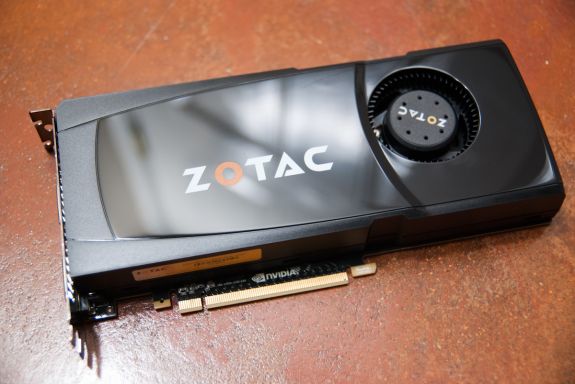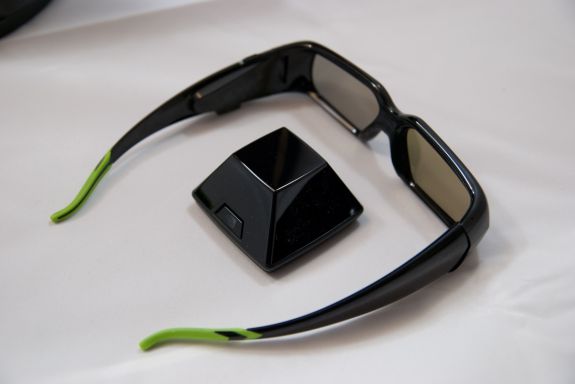ASUS VG236H 23-inch 3D Display Review: 120Hz is the Future
by Brian Klug on August 7, 2010 2:48 AM EST3D Vision on the VG236H
So let’s talk about 3D for a bit before going into the deep bits of the display’s performance. We’ve already covered NVIDIA’s 3D Vision here, but this review would just be incomplete without discussing how much I’ve changed my mind about 3D after playing with the VG236H.
First off, the NVIDIA 3D Vision kit itself is unchanged, though the packaging is a bit more compact. Inside is a soft cloth bag for the classes, two different nasal guides for comfort, two different length USB cables, the IR base station pyramid, shutter glasses, and demo and driver CDs. It feels like a high end product, with the base station pyramid and glasses sitting in foam cutouts, and the requisite accessories in a compartment above.
Additionally, you’ll need a 3D Vision compatible GPU, and can only drive 120Hz refresh rates over DVI-D, not HDMI. Because you’re rendering twice the frames (one for each eye), you’ll take a framerate hit for enabling 3D, so that GPU best be powerful. Zotac graciously supplied their ZOTAC GeForce GTX 470 for testing, which worked perfectly in my testbench.
I noted before that I’ve been skeptical about mainstream 3D gaming for some time now. I’ve seen my fair share of 3D content - though not as much as most of the other AnandTech writers that experienced it at CES on myriad displays - but have an above average grasp for the tech thanks to my optical sciences background.
That out of the way, most of the shutter or polarization based methods I’ve seen up until now suffered from being flickery. Refresh rate just wasn’t high enough, and the result was that I could detect individual frames when moving my head or really looking for it. In theaters, I tried the circularly polarized passive RealD system, and another IMAX 3D system using linear polarization. I had also tried a number of active LCD shutter systems on LCD TVs. While impressive, all of them had noticeable flicker.
The VG236H is the first 3D implementation I’ve played with that doesn’t have noticeable flicker. It just doesn’t. I was immediately impressed with the NVIDIA 3D Vision setup.
NVIDIA thankfully has a pretty comprehensive list of 3D Vision games and how good they perform with the whole system. At the top of the scale is 3D Vision Ready, meaning the game has basically been developed from the start to be viewed in 3D or 2D. Down the list is excellent, good, fair, poor, and not recommended. I first tried a number of ‘good’ titles, and found that while the 3D experience indeed worked, but often small things got in the way.













121 Comments
View All Comments
B3an - Sunday, August 8, 2010 - link
Is 120hz possible on a 2560x1600 monitor? As the res is the highest a DVI dual-link cable can handle, and i'm not sure if the latest Display Port or HDMI specs have enough bandwidth for 120hz at this res? Anyone know?mac2j - Sunday, August 8, 2010 - link
Is 120HZ possible on a 2560x1600 ?Yes. And personally I agree that would be my dream also ... although we're probably talking ~$2000. The mostly likely place to look would be Dell's next revision of the 2008WFP.
The other consideration is you'd need a serious graphics card to drive 3D at that resolution with that framerate .... really with the current offerings you're probably looking at needing the top 1 or 2 models in SLI for good performance.
I have a rudimentary understanding of where monitors excel in relationship to TVs in this area but can anyone tell me what kind of performance/picture you could expect using one of the new 240Hz 3D TVs as a monitor?
mac2j - Sunday, August 8, 2010 - link
Ugh type I meant 3008WFP ... need edit button...DarkUltra - Sunday, August 8, 2010 - link
No you need DisplayPort to get 2560x1600 at 120hz. Dual link DVI maxes out at about 1300p 120hz. If you have such a high resolution and lack the 3d perfromance, why not run games at half, say 1280x800. Fonts in Windows look real nice in high dpi on my crt (1530p 134dpi)mac2j - Monday, August 9, 2010 - link
OK here's the breakdown as far as I can tell:Regular DVI & HDMI <1.3 max out at 1920x1200x60Hz.
Dual-link DVI maxes out at 1920x1200x120Hz
HDMI 1.3 & DisplayPort 1.0 max out at 1680x1050x240hz
1920x1200x140hz or 2560x1600x120hz would require DisplayPort 1.2 or HDMI B (which may become 1.5)
Nothing I've heard of can handle 2560x1600x240hz as far as I know (would require =24 Gbit/s capacity)
mac2j - Monday, August 9, 2010 - link
Its worth mentioning that as far as I know the first commercial cards to support DisplayPort 1.2 will be the ATI 6000 series late this year but I could be wrong.B3an - Monday, August 9, 2010 - link
I've got two 5870's and they run pretty much everything at 2560x1600 no problem, even with AA + AF... not really anything these days that really stresses cards like games used to, too much console port crap. Also had a single GTX480 and that could get way over 60+FPS at this res with 98% of games.So after looking into it... mac2j is right, Display Port 1.2 should definitely be able to do 2560x1600 @ 120hz.
Just hope the 3008 replacement can do 120hz, but i highly doubt it will, these monitors are not really for gamers, even though it would benefit other things too...
ralgha2001 - Monday, July 11, 2011 - link
I know this may be a dumb question.. but could I use a Samsung 40" Full HD TV (S-PVA supposedly 4 ms response) @ 120 hz for gaming and have 1920x1080 @ 120 hz (it has HDMI and RGB inputs). I don't quite care about 3D but I would like to know if I could do gaming on this and skip buying a new monitor for now..I'm actually building a new rig from ground zero. I'm thinkin in nvidia's GTX 580 and a mobo for the intel 1155 socket (maybe along the 2500K to save some bucks from 2600K). Since detailing the other components might not be needed or care about I'm stopping here.
But I'm not sure if i should go for the AW2310 or another current monitor since I might still be able to go with my HDTV and save a bunch. Doesn't seem like an actual option since nobody seems to mention it and still wonder in with monitors @60 hz.
Thanks!
TareX - Sunday, August 8, 2010 - link
Any shutter glasses system is not the future.The future is autostereoscopic lenticular lens 3D screens.
bill4 - Sunday, August 8, 2010 - link
I think you guys play fast and loose with the input lag tests. It's great that you do them though, dont get me wrong.For one thing as far as I know, turning almost any processing on only increases lag. For that reason I'm rather doubtful turning overdrive on reduced lag. I mean think about it, if the display has to process the image in any way, you're adding lag.
Next you mention some monitor that you claim has no scaler and no lag. Well again as far as I know, ANY LCD display inherently has lag. So again I'm rather dubious.
In total, it reads like you wanted this monitor to have low lag, because you liked it so much, so you sort of brushed aside evidence otherwise.
I dont understand how in the same article you run a test apparently showing it to have 14 ms lag, then later claim it has 3.9 ms by comparing it with some third monitor. It just doesnt make sense, and is confusing at the least. Which test do you consider definitive? And if this third LCD has no lag, why didn't you test it versus a CRT? Simply having no scaler is not proof it has no lag.
I mention this because in the HDTV lag thread at AVS forums, it's a generally accepted tenant that 120hz displays have more lag than 60 hz ones. That's why I would expect this 120hz display to have relatively more lag, such as your first test seemed to hint at.